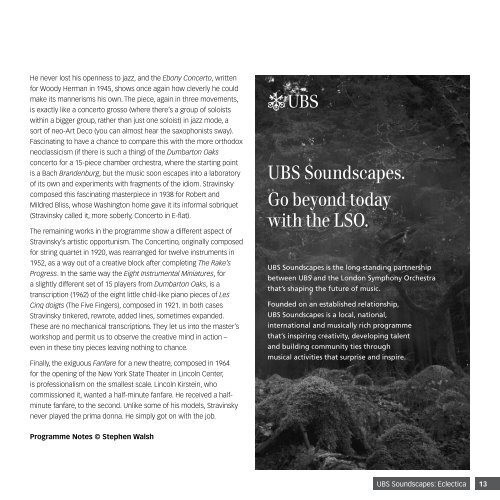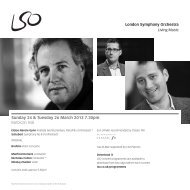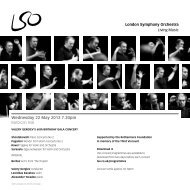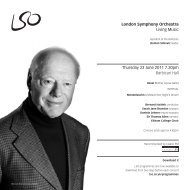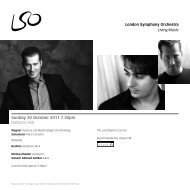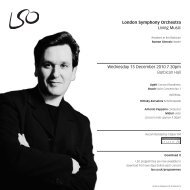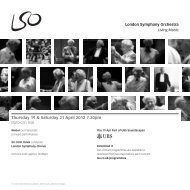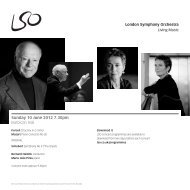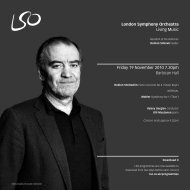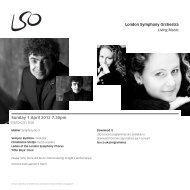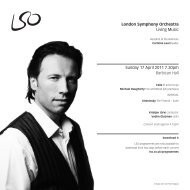Programme PDF - London Symphony Orchestra
Programme PDF - London Symphony Orchestra
Programme PDF - London Symphony Orchestra
Create successful ePaper yourself
Turn your PDF publications into a flip-book with our unique Google optimized e-Paper software.
He never lost his openness to jazz, and the Ebony Concerto, written<br />
for Woody Herman in 1945, shows once again how cleverly he could<br />
make its mannerisms his own. The piece, again in three movements,<br />
is exactly like a concerto grosso (where there’s a group of soloists<br />
within a bigger group, rather than just one soloist) in jazz mode, a<br />
sort of neo-Art Deco (you can almost hear the saxophonists sway).<br />
Fascinating to have a chance to compare this with the more orthodox<br />
neoclassicism (if there is such a thing) of the Dumbarton Oaks<br />
concerto for a 15-piece chamber orchestra, where the starting point<br />
is a Bach Brandenburg, but the music soon escapes into a laboratory<br />
of its own and experiments with fragments of the idiom. Stravinsky<br />
composed this fascinating masterpiece in 1938 for Robert and<br />
Mildred Bliss, whose Washington home gave it its informal sobriquet<br />
(Stravinsky called it, more soberly, Concerto in e-flat).<br />
The remaining works in the programme show a different aspect of<br />
Stravinsky’s artistic opportunism. The Concertino, originally composed<br />
for string quartet in 1920, was rearranged for twelve instruments in<br />
1952, as a way out of a creative block after completing The Rake’s<br />
Progress. In the same way the Eight Instrumental Miniatures, for<br />
a slightly different set of 15 players from Dumbarton Oaks, is a<br />
transcription (1962) of the eight little child-like piano pieces of Les<br />
Cinq doigts (The Five Fingers), composed in 1921. In both cases<br />
Stravinsky tinkered, rewrote, added lines, sometimes expanded.<br />
These are no mechanical transcriptions. They let us into the master’s<br />
workshop and permit us to observe the creative mind in action –<br />
even in these tiny pieces leaving nothing to chance.<br />
Finally, the exiguous Fanfare for a new theatre, composed in 1964<br />
for the opening of the new York State Theater in Lincoln Center,<br />
is professionalism on the smallest scale. Lincoln Kirstein, who<br />
commissioned it, wanted a half-minute fanfare. He received a halfminute<br />
fanfare, to the second. Unlike some of his models, Stravinsky<br />
never played the prima donna. He simply got on with the job.<br />
<strong>Programme</strong> Notes © Stephen Walsh<br />
UBS Soundscapes is the long-standing partnership<br />
between UBS and the <strong>London</strong> <strong>Symphony</strong> <strong>Orchestra</strong><br />
that’s shaping the future of music.<br />
Founded on an established relationship,<br />
UBS Soundscapes is a local, national,<br />
international and musically rich programme<br />
that’s inspiring creativity, developing talent<br />
and building community ties through<br />
musical activities that surprise and inspire.<br />
UBS Soundscapes: Eclectica<br />
13


